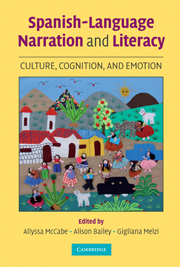Book contents
- Frontmatter
- Contents
- List of Contributors
- Preface
- Acknowledgments
- 1 Introduction
- PART ONE PARENT–CHILD NARRATIVES
- PART TWO DEVELOPING INDEPENDENT NARRATION
- 7 The Intersection of Language and Culture Among Mexican-Heritage Children 3 to 7 Years Old
- 8 Beyond Chronicity: Evaluation and Temporality in Spanish-Speaking Children's Personal Narratives
- 9 Narrative Stance in Venezuelan Children's Stories
- 10 Mestizaje: Afro-Caribbean and Indigenous Costa Rican Children's Narratives and Links with Other Traditions
- PART THREE NARRATIVE LINKS TO LITERACY AND OTHER SCHOOL ACHIEVEMENTS
- Author Index
- Subject Index
- References
10 - Mestizaje: Afro-Caribbean and Indigenous Costa Rican Children's Narratives and Links with Other Traditions
Published online by Cambridge University Press: 05 June 2012
- Frontmatter
- Contents
- List of Contributors
- Preface
- Acknowledgments
- 1 Introduction
- PART ONE PARENT–CHILD NARRATIVES
- PART TWO DEVELOPING INDEPENDENT NARRATION
- 7 The Intersection of Language and Culture Among Mexican-Heritage Children 3 to 7 Years Old
- 8 Beyond Chronicity: Evaluation and Temporality in Spanish-Speaking Children's Personal Narratives
- 9 Narrative Stance in Venezuelan Children's Stories
- 10 Mestizaje: Afro-Caribbean and Indigenous Costa Rican Children's Narratives and Links with Other Traditions
- PART THREE NARRATIVE LINKS TO LITERACY AND OTHER SCHOOL ACHIEVEMENTS
- Author Index
- Subject Index
- References
Summary
“Just tell them who we are and that we are not all alike.”
– Quote from Margarita Ávila in Latinos, by Earl Shorris (1992)Key Words: narratives, children, Costa Rica, Dominican Republic, Indigenous, Afro-Caribbean
ABSTRACT
This study examined the relationship between children's narratives and a number of diverse social and cultural influences in one Dominican American and four Costa Rican Indigenous communities to explore Spanish narration in areas of linguistic and social contact. Of the total number of narratives collected, 30 were from 17 Costa Rican children (7 girls, 10 boys) of Indigenous or Afro-Caribbean descent and 36 were from 12 children (6 girls, 6 boys) from the Dominican Republic living in the United States. All children interviewed were native speakers of Spanish between the ages of 6 and 9 years (M age = 7;1). Personal narratives were isolated from recorded conversations, transcribed, and scored using both highpoint and story grammar analyses. When compared to a number of other ethnic groups both inside and outside of Latin America, the Indigenous and Afro-Caribbean narratives gathered in this study differed considerably and suggest that – whereas many distinct ethnic minority groups are absorbing national languages and traditions – vestigial cultural elements are being retained in children's narrative structure and content. Results are discussed relative to the narrative practices emerging from cultural and linguistic contact.
- Type
- Chapter
- Information
- Spanish-Language Narration and LiteracyCulture, Cognition, and Emotion, pp. 237 - 270Publisher: Cambridge University PressPrint publication year: 2008
References
- 4
- Cited by

